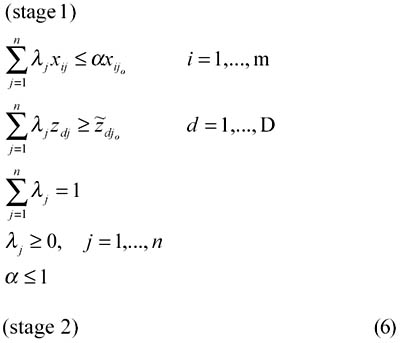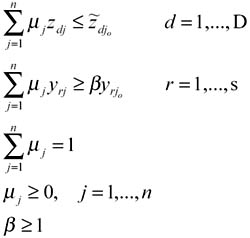THE MODEL
THE MODELConsider the indirect impact of IT on banking performance where IT directly impacts certain intermediate measures which in turn are transformed to realize banking performance. Figure 2 describes the indirect impact of IT on banking performance where the first stage use inputs xi (i =1, , m) to produce outputs zd ( d = 1, , D), and then these zd are used as inputs in the second stage to produce outputs yr (r = 1, , s). It can be seen that zd (intermediate measures) are outputs in stage 1 and inputs in stage 2. The first stage is viewed as an IT-related, value-added activity where deposit is generated and then used as the input to the second stage where revenue is generated. Based upon Chen and Zhu (2001), we have min w1α + w2β
where w1 and w2 are user-specified weights reflecting the preference over the two stages' performance, and symbol "∼" represents unknown decision variables. The rationale of model (6) is as follows: (i) when we evaluate the impact of IT investment on the intermediate measures, we want to minimize the input usage given the intermediate measures. For example, given the deposits generated, our objective is to examine whether a bank can reduce its input consumption (including IT investment) compared to the best practice, and (ii) when we evaluate bank performance as a result of the intermediate measures, we want to maximize the performance given the intermediate measures. For example, given the deposits it generated, our objective is to examine whether a bank can increase its profit. Model (6) characterizes the indirect impact of IT on banking performance in a single linear programming problem. Theorem 1 If α* = β * = 1, then there must exist an optimal solution such that λ*jo = μ*jo = 1, where (*) represents optimal value in model (6). [Proof]: Note that λ*jo = μ*jo = 1, α*=β*=1, and Theorem 2 If α* = β* = 1, then θ* = 1 and Φ* = 1, where θ* and Φ* are the optimal values to models (2) and (3), respectively. [Proof]: Suppose α* = β * = 1 in model (6). By Theorem 1, we know that λ*jo = μ*jo = 1, α*=β*=1, and Theorem 2 indicates if α* = β * = 1, the value-chain achieves efficient performance when the two-stage process is viewed as a whole. If α* = 1 and β * > 1 (or α* < 1 and β * = 1), then model (6) indicates that one of the stages can achieve 100% efficiency given a set of optimal intermediate measures. In this case, the original DEA models (2) and (3) can be used to provide additional information. From Theorem 2, we immediately have the following result: Corollary A bank must be a frontier point in both stages with respect to Based upon the above Corollary, model (6) yields directions for achieving the best practice of this two-stage process. Consequently, we can study the marginal impact of IT investment on banking performance by using returns to scale estimation discussed in Seiford and Zhu (1999) (see Chen & Zhu, 2001, for such a study). In model (6), the intermediate measures for a specific bank under evaluation are set as unknown decision variables,
| |||||||||||||||||||||||||||||||||
| | |||||||||||||||||||||||||||||||||
EAN: 2147483647
Pages: 194


